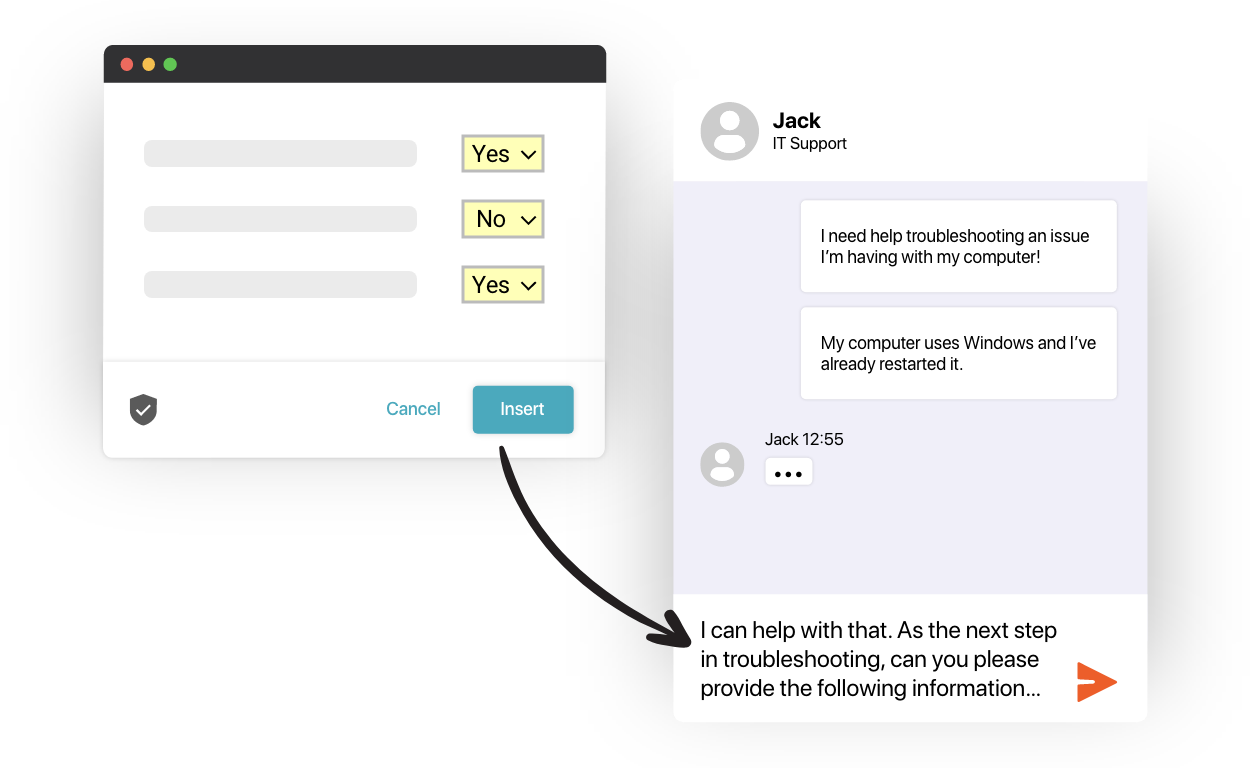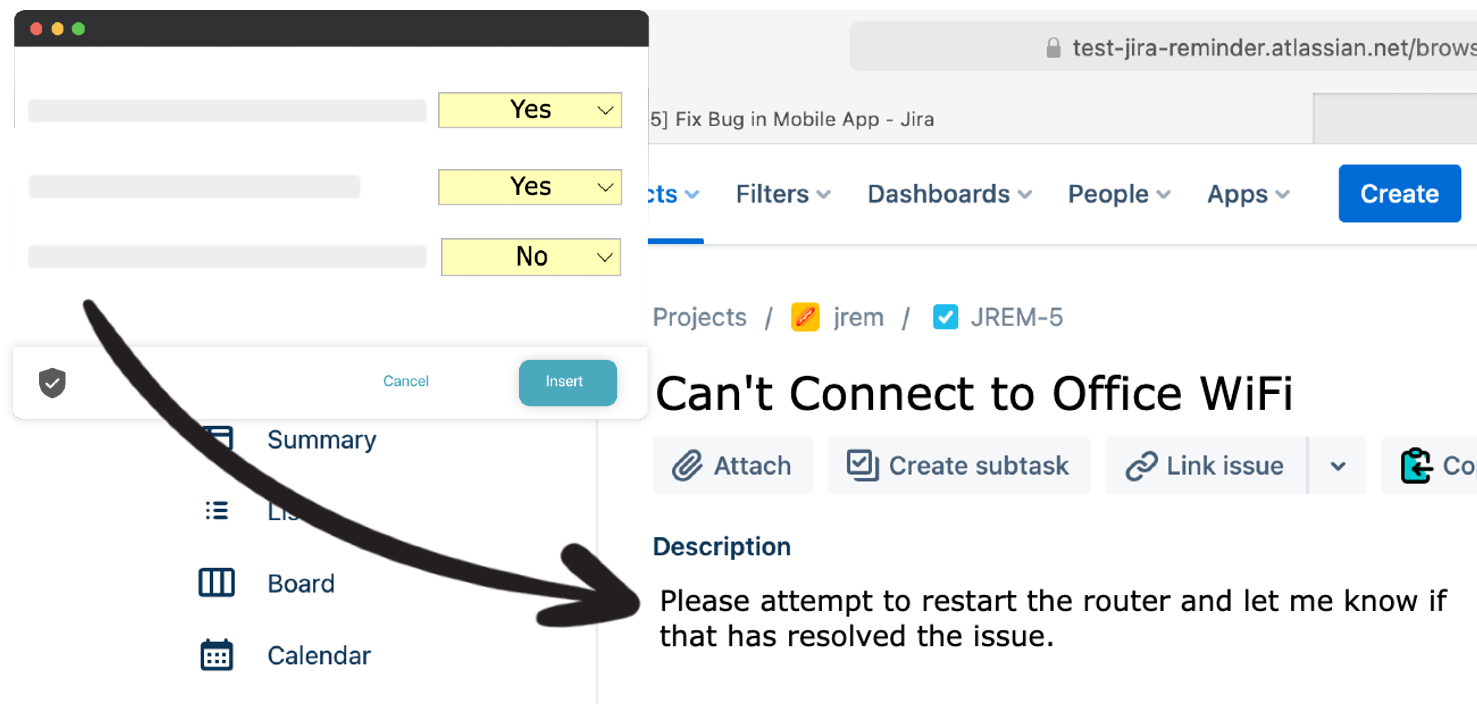Best Practices for Creating Interactive SOPs that Your Team Will Actually Use and Follow
A collection of best practices we've learned from working with Text Blaze customers to create Standard Operating Procedures.
What are Standard Operating Procedures?
Standard Operating Procedures, or SOPs, are a great way to standardize processes across a team. SOPs provide clear, step-by-step guidance about how to work through a process. PennState describes the value of SOPs as follows:
Well-written standard operating procedures (SOPs) provide direction, improve communication, reduce training time, and improve work consistency.
They're used in virtually all industries, and prove especially useful for scenarios that have a variety of different potential outcomes. By moving through a decision tree, the person following the SOP reaches the right outcome based on the scenario at hand.
Standard operating procedures can also take the form of checklists, where someone is tasked with completing a list of items that roll up into the completion of a broader objective. They provide specific, actionable guidelines for what constitutes a task that is completely done.
Common Challenges with Implementing SOPs
When learning how to write standard operating procedures, there's often the concern that your team won't follow them. If they're not going to follow them, the effort to create them was in vain and that's a frustrating experience. Some of the more common reasons that SOPs aren't followed when they're rolled out include:
- The process is so complex that an SOP document is still too hard to follow.
- Most SOPs aren't interactive, and people make mistakes while following them. This can result in poor customer experiences and wrong answers.
- The SOP tells the follower what the process is, but it doesn't help them craft a response or message at the end of the process.
- The SOP is buried in another tool or system, and people don't know where to find it - so they don't follow it.
How Text Blaze Addresses These Challenges
Text Blaze brings SOPs to life, turning them from static documents or confusing flowcharts into interactive guides that are available directly inside the tools where you're already doing your work. This article provides best practices for creating SOPs in Text Blaze, so you can create procedures that your team will actually follow.
Join thousands of teams who are using Text Blaze templates.
Best Practices For Implementing SOPs
Proceed Through the Process One Step at a Time
Long, complex SOPs can be intimidating, especially if you're in a role where quick responses and high volume are expected of you, like customer support roles.
Structuring them in a way that presents the process step by step in the most digestible way is important. Don't make your team wade through super-long documents where they have to jump around from section to section to find what they need.
Using Text Blaze's rules, or conditional logic, feature, SOPs can be presented one step at a time. You can avoid showing unnecessary steps or alternative paths that aren't relevant to this specific scenario, and make the process more digestible to the user of the SOP.
In the example below, you'll see that each step of the process is presented only when the previous step is complete. The next step that's presented is dynamic and conditional on what the previous step's response was.
{error: Follow process for WiFi outage} {endif}{if: wifienabled=no}
{error: Check Network Settings – Re-enable if necessary, enter WIFI password, check connection to Google}
Did that resolve the issue? {formmenu: ; yes; no; name=resolve1}{elseif: wifienabled=yes} Can other devices connect? {formmenu: ; yes; no; name=otherdevices}{endif}{if: wifienabled=yes and otherdevices=no}
{error: Try restarting the router}
Did that resolve the issue? {formmenu: ; yes; no; name=resolve2}
{elseif: (wifienabled=yes and otherdevices=yes) or resolve1=no} Can the user connect their laptop to their mobile data? {formmenu: ; yes; no; name=mobileconnect}{endif}{if: mobileconnect=yes} Is the mobile data a different provider? {formmenu: ; yes; no; name=mobiledifferent}{endif} {endnote}{if: resolve2=yes or resolve1=yes} Great, I'm going to close this ticket since the issue has been resolved.{elseif: resolve2=no or mobiledifferent=yes} You will need to contact the broadband supplier to resolve this issue.{elseif: wifienabled=yes and otherdevices=no and resolve1=yes} Great, I'm going to close this ticket since the issue has been resolved.{elseif: mobiledifferent=no or mobileconnect=no} I will need to pass this incident to relevant 2nd Line Support for further investigation.{endif}
The best practice of avoiding information overload is absolutely key to a successful SOP rollout.
Make SOPs Interactive, and Validate Accuracy in Real-Time
Typically SOPs are static documents that someone follows: they read through a written guide, or they follow a flow-chart. As the author of an SOP, you cross your fingers and hope that people actually follow these steps accurately.
Using a tool to bring SOPs to life can help with this. By having your SOPs be interactive, the person following the guide will get feedback in real time about whether or not they're following it accurately. You can put "sanity checks" in place periodically throughout the SOP to help ensure that steps aren't overlooked or important processes aren't skipped.
Using Text Blaze's real-time validation feature ensures that processes are followed accurately. If there are outcomes that are not possible based on certain conditions, or someone makes a mistake during one of the steps, they can be alerted to the error while following the SOP, instead of after they've already provided the wrong answer or took a misstep.
Below is an example of an SOP a salesperson might use to determine who on their account team can assist a prospect or customer. Text Blaze will ensure that the right action is taken regardless of the scenario.
{error: Forward the request to Support for them to actively troubleshoot the request}{elseif: q1=no}
If this a prospect or a closed customer? {formmenu: ; prospect; closed customer; name=custtype}
What is the customer's question about? {formmenu: ; general functionality; integrations; billing; renewal; setting up specific features; additional demo request; name=topic}{endif}{if: q1=no and topic="general functionality" and custtype="prospect"}
{error: Sales reps are responsible for these types of questions for prospects, so please reply to them directly. If you need assistance crafting the message or need clarification about the functionality in question, engage support.}{elseif: q1=no and topic="general functionality" and custtype="closed customer"}
{error: Because this is a closed customer, loop in their Customer Success Manager (CSM) for assistance. If you're not sure who that is, check the Account in Salesforce.}{elseif: q1=no and (topic="integrations" or topic="setting up specific features") and custtype="prospect"}
{error: This type of request is handled by Solutions Engineers. Check Salesforce to see which SE is assigned to this account, and circle them in.}{elseif: q1=no and (topic="integrations" or topic="setting up specific features") and custtype="closed customer"}
{error: Because this is a closed customer, loop in their Customer Success Manager (CSM) for assistance. If you're not sure who that is, check the Account in Salesforce.}{elseif: q1=no and topic="billing" and custtype="prospect"}
{error: Sales reps are responsible for these types of questions for prospects, so please reply to them directly. Ask your manager for guidance and pricing approval where required.}{elseif: q1=no and topic="billing" and custtype="closed customer"}
{error: Customer Success Managers are responsible for these types of billing questions. Involve the CSM for assistance. If this becomes a negotiation, they may ask you to step back in for further assistance.}{elseif: q1=no and topic="renewal"}
{error: Customer Success Managers are responsible for renewals. They may ask you to stay involved, but circle in the CSM to lead this process.}{elseif: q1=no and topic="additional demo request" and custtype="prospect"}
{error: Sales reps should run all demos for prospects, so please set up time with the customer to run them through the demo. If you expect there to be technical deep-dives required, circle in the Solutions Engineer. You can see which SE is assigned to this account in Salesforce.}{elseif: q1=no and topic="additional demo request" and custtype="closed customer"}
Is this demo request for more users under the existing use-case, or would this be for a new group of stakeholders / a new use-case? {formmenu: ; existing use-case; new use-case; name=demotype}{endif}{if: q1=no and topic="additional demo request" and custtype="closed customer" and demotype="existing use-case"}
{error: Customer Success Managers are responsible for demos of this type. They may ask you to stay involved, but circle in the CSM to lead this demo.}{elseif: q1=no and topic="additional demo request" and custtype="closed customer" and demotype="new use-case"}
{error: For potential expansion, the Sales rep should run this demo. Include the Customer Success Manager for the account. Also bring in the Solutions Engineer if a technical deep-dive will be required. The CSM and SE for the account are both listed in Salesforce.}{endif} {endnote}
Help with Messaging, not just Outcomes
While it's great that an SOP can lead you to the correct end of a process, it leaves the user of the guide stranded at the end when it comes to messaging. They likely still have questions: what's the right thing to say at the end of the process? What's the approved company language for this scenario?
Final outcomes in SOPs shouldn't just be a single line of text telling the reader that they've reached the end. They should know that they've reached the end, and it should also provide them with very specific instructions about what to say or signal now that they've reached a final decision. One example might be to include specific, company-approved language for anything being signaled to customers.
Text Blaze can save users up to 28 hours per month by eliminating repetitive typing. As a best practice, the conclusion of your SOPs should provide specific language to be used in the response or message that comes from following the SOP. Text Blaze can automatically write that message for you, in any system where you do your work.

Join thousands of teams who are using Text Blaze templates.
SOPs that are Available Everywhere
This is probably the most common reason that processes aren't followed: people have to go out of their way to find the SOP, and often they don't know where it is or what to search for to find it.
When publishing your SOPs, you'll want to put them in places where people know to look for them, and include a many keywords as possible to help someone find it when they need to. Follow up publishing your SOPs with clear communication to teams as to where to find what they need. Hands-on training to run them through the processes helps solidify their knowledge as well - it's a lot to ask to have people learn solely from written documentation like an SOP with no additional training.
Text Blaze provides a variety of ways to access your SOPs in virtually any tool or system, in context with where your team is already doing their work.
Simply type a keyboard shortcut (for instance, /sop) to open the SOP, or select it from a menu that's available anywhere you're working.

Key Takeaways for Creating Great SOPs
Providing teams with guidance and clarity about how to approach different processes is the key to having a team that runs well and efficiently.
By using Text Blaze to power your SOPs, you can further increase your efficiency. Bring your SOPs to where your team is doing their work, make them interactive so they're easier to follow, add validation to ensure they're followed accurately, and go through the processes one step at a time to reduce confusion.




